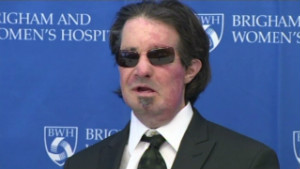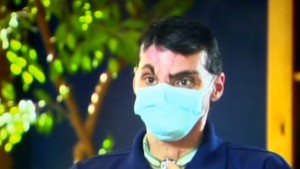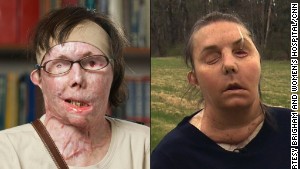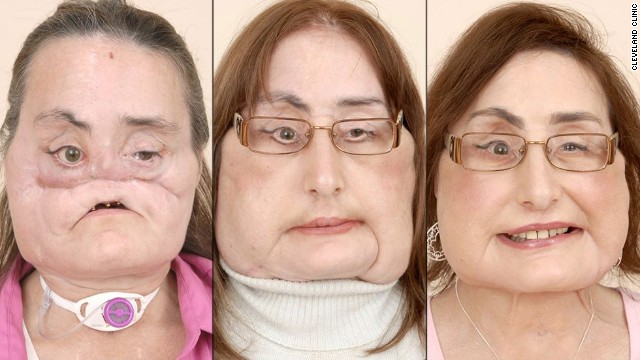STORY HIGHLIGHTS
- Connie Culp received the first near-total face transplant in the U.S. in 2008
- Dallas Wiens underwent the nation's first full facial transplant in 2011
- Wiens is now married to a burn victim
May 3, 2013
Editor's note: Readers responded Wednesday to the story of Carmen Tarleton, who publicly revealed her new face after undergoing a full-face transplant in February. Here, we catch up with others who have had face transplants.
(CNN) -- Since 2008, the United States has seen several landmark surgeries in face transplantation, giving people with severely deformed faces new lives through partially or totally different faces from donors.
Receiving a new face is anything but easy. The surgery requires long hours with many medical specialists collaborating to make it happen. The patient then has to adjust to the new face, biologically and psychologically.
There is a complex rehabilitation process where the patient learns how to eat, speak and make facial expressions again, said Dr. Maria Siemionow, director of plastic surgery research at the Cleveland Clinic.
"The surgical procedure itself of transplant is relatively standard," Siemionow said. "The major problem is the selection of the candidate -- who is and who is not the face transplant candidate."
For instance, doctors at the Cleveland Clinic would not consider someone who is totally blind because one of the requirements is to be able to exercise one's face in front of a mirror, "to make the face adjusted to the brain," she said about this still emerging field of surgery.
Here are the major publicly reported cases of facial transplants in the U.S.:
Connie Culp
Surgery: December 2008
Connie Culp received the first near-total face transplant in the U.S.She was injured by a bullet in 2004 when her husband shot her. Culp was left partially blind, unable to smell and speak, and dependent on a surgical opening in her neck to breathe. (Theworld's first full-face transplant was done in Spain in 2010.)
A 22-hour operation at the Cleveland Clinic gave her most of a new face from a donor: Anna Kasper of Lakewood, Ohio.
Culp met the family of the donor in December 2010. She said around the same time that she was happy with the transformation.
"I can smell now," she told CNN in 2010. "I can eat steak, I can eat almost any solid foods -- so it's all getting better."
Siemionow, who led the surgery, said Thursday doctors at the hospital have been seeing Culp on a monthly basis since the transplant. She described Culp as "fully integrated back in her community." She is "a happy grandmother" with a boyfriend, and she is "very joyful."
Culp, now 49, is able to smile, frown and talk, and her speech is easily understood, Siemionow said. Before, Culp did not have a nose; now, she can breathe through it. Researchers have determined that Culp's brain accepts the new face, based on activity in key brain areas.
She is an advocate of organ donation and travels to deliver speeches about her experience.
"She's a very powerful personality to actually share her experience to help others," Siemionow said.
James Maki
Surgery: April 2009
James Maki destroyed the entire core of his face when he fell onto the electrified third rail at a Boston subway station on June 30, 2005. He also suffered severe burns on his arms and hands. His breathing was impaired, and he couldn't speak coherently. Eating was also impossible; he was fed through a tube in his stomach.
A team of surgeons and other specialists worked for 17 hours at Boston's Brigham and Women's Hospital to give him a new face from a donor. Maki, who wore dentures before the accident, also got new teeth during the operation. But the teeth didn't take and eventually began to break.
He's now in the process of getting eight false teeth implanted into his mouth, and he'll have a new set of dentures, too.
"I'm going to have all my teeth," Maki, 63, said Thursday. "I'm looking forward to eating a lot of things -- like I have to eat stuff that's really soft. Once I get the teeth in, I can eat whatever. Cashews. Whatever I like."
He says he can't wait to eat a rib-eye steak.
Maki is also making facial expressions again. He says he has his good days and bad days. He's taken up the game of bridge at his local senior center.

Dallas Wiens
Surgery: March 2011
Dallas Wiens underwent the first full facial transplant in the United States. When Wiens was painting his church as a volunteer in November 2008, his head got too close to a high-voltage power line. He lost almost his entire face from the burns.
Doctors kept Wiens in a medically induced coma for 90 days. In March 2011, he received a new face in a 15-hour procedure at Brigham and Women's Hospital.
"When I woke up, and I was able to feel I had features again -- eyes and a nose and a mouth -- I even said out loud that this could not be medically possible," Wiens said in May 2011. "But here I am today."
Wiens recently married Jamie Nash, a woman who suffered burns on more than 70% of her body after a car crash.
"Our love is deep and strong, and together we will achieve greatness," Nash wrote on the Jamie Nash TXT L8R Foundationwebsite.
Mitch Hunter
Surgery: April 2011
Mitch Hunter suffered significant injuries in a 2001 car accident, in which he received a severe shock from a high-voltage electrical wire.
The Indiana man was the second full-face transplant recipient in the United States.
A 14-hour surgery gave Hunter a nose, eyelids and facial animation muscles and nerves, Brigham and Women's Hospital said.
In most of his face, Hunter now has near-normal sensation. His speech has continued to improve.
"Mitch reports that he is very happy with both the aesthetic and the functional outcomes of his operation, and enjoys spending as much time as possible with his family and friends," the hospital said in a statement. "He recently has taken on active pursuits, including running and training for endurance races. He also has a job in his home state of Indiana and is planning to obtain a degree in information systems."
Charla Nash
Surgery: May 2011
Charla Nash was mauled by a friend's chimpanzee, leaving her without a nose, eyelids, lips or hands. Brigham and Women's Hospital surgeons performed a full facial transplant in a 20-hour procedure.
Initially, she also received two new hands through transplantation as well. A few days later, though, Nash became sick, and the hands were removed.
The first post-surgery pictures of her were released in August 2011.
She said at that time: "I will now be able to do things I once took for granted ... I will have lips and will speak clearly once again. I will be able to kiss and hug loved ones. I am tremendously grateful to the donor and her family."

Video at http://www.cnn.com/2013/05/02/health/face-transplant-patients/

Video at http://www.cnn.com/2013/05/02/health/face-transplant-patients/
Richard Lee Norris
Surgery: March 2012
Richard Norris from Virginia was a gun accident in 1997 that took away much of his upper and lower jaws, in addition to lips and nose. He needed a trachea tube to breathe. He wore a surgical mask for 15 years, hiding his deformities from the world.
A team of specialists at the University of Maryland Medical Center performed the procedure, which lasted 36 hours. The surgery involved replacing both jaws, as well as tongue, and skin and underlying nerve and muscle tissue, and an entire set of teeth. Essentially, his entire face was replaced except for his eyes and the back remnant of his throat.
Doctors said Norris' was the most extensive surgery of its kind.
Norris said in a statement in October, "I am doing well. I spend a lot of my time fishing and working on my golf game. I am also enjoying time with my family and friends."
The 37-year-old spoke at a University of Maryland fundraising gala on Saturday, his first public appearance since the surgery, according the a hospital spokesman.
"Thank you for the years spent preparing to give me a new life," he said, according to CNN affiliate WJZ.
In memory of the deceased donor, he said, "Thank you, Joshua. We will always be grateful to you and your family for this gift of life."

Carmen Blandin Tarleton
Surgery: February 2013
Carmen Blandin Tarleton became disfigured after her estranged husband doused her with industrial-strength lye. The lye burned more than 80% of her body, and the burns went all the way through her skin. Children would run away from her because of her appearance.
Tarleton was approved for a full facial transplant in December 2011, and it took 14 months to find a donor. The transplant surgery, performed by specialists at Brigham and Women's Hospital, took 15 hours.
Today, Tarleton is completely blind in one eye and partially blind in the other, but she is still able to live on her own in her apartment in Vermont.
She told CNN she especially looks forward to gaining the strength and coordination to kiss the man she calls "the love of my life."
"I can't pucker and feel yet," she said. "But I am looking forward to that day. I know that day will come."
CNN's John Bonifield, Madison Park and Elizabeth Cohen contributed to this report.
 Connie Culp was injured when her husband shot her in 2004. She underwent a near-total face transplant at the Cleveland Clinic in 2008 -- the first operation of its kind in the United States.
Connie Culp was injured when her husband shot her in 2004. She underwent a near-total face transplant at the Cleveland Clinic in 2008 -- the first operation of its kind in the United States.
No comments:
Post a Comment